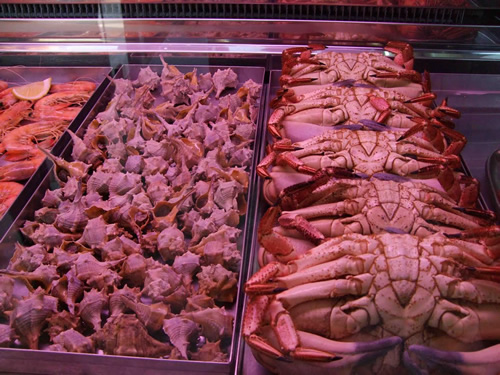How and Where to Eat and Drink Well in Lisbon
Articles and photos by Beebe Bahrami

|
|
Nouveau bacalao at a typical restaurant in Lisbon.
|
St. Vincent is the patron saint of wine and Lisbon's official patron saint, representing the city's culinary and enological feast enjoyed by many daily.
Unofficially, Lisbon has another patron saint, St. Anthony of Padua, who was actually from Lisbon before he went eastward and made his name in other lands.
Both saints are celebrated with good food and wine. Locals say that the city, neighborhood by neighborhood, turns into one big party on June 13, St. Anthony's feast day. A particular signature of St. Anthony's feast is freshly grilled sardines savored with cold, frothy beer or crisp white wine..
Portugal has two essential sources of excellent food and wine: the indigenous agrarian-herding-fishing-wine-growing traditions and the seafaring explorations around the world over many centuries.
As Portugal's capital, Lisbon is the recipient of all the peoples whom the Portuguese Empire absorbed and invited into the tremendous pan-Portuguese global party that makes its mark in the capital. Here, traditional Portuguese cuisine mingles with Cape Verdean, Brazilian, Mozambican, and Goan cuisines, among many others. Such diversity pairs well with the locally grown and harvested fruits, vegetables, fishes, meats, nuts, and fowl, making for one of Europe's most intriguing culinary hotspots.
A common practice in Portuguese restaurants is to set down an appetizer of either little disks of sheep's milk cheeses and olives or little savory toasts with just about anything layered on top. These morsels are delicious and offer a good sampling of local cuisine, but you will be charged a few Euros and centimes for them. Otherwise, the waiter will whisk them away as your order arrives.
Here are my suggestions on how to join the party and eat really well in Lisbon:
Please get to know the neighborhoods, especially the Alfama, Castelo, Graça, Rossio, Chiado, and Bairro Alto, by leisurely walking around them and soaking up their unique atmospheres.
Take a Culinary Walking Tour
in Lisbon
Lisbon has a bounty of terrific walking tours.
Lisbon Walker offers an excellent Mysteries & Legends Tour and other historic tours of the old neighborhoods.
Another excellent tour guide operator, Inside Lisbon, organizes a Gourmet walking tour designed to broadly expose you to Lisbon's culinary highlights.
Be sure to tip your guide at the end of the tour, a custom many visitors seem to ignore and one with which the Portuguese are too polite to make an issue.
Go to the Market
in Lisbon
Take in the daily colors and culinary catch at the Mercado da Ribeira, Lisbon's famous covered market memorialized in Portugal's unique blues-like fado music by such greats as Amália Rodrigues

|
|
A sampling of seafood at a market in Lisbon.
|
Sample the Wines
Sample the varied Portuguese wines at cafes and taverns throughout the neighborhoods. Be sure to stop for a small glass of ginginha, a robust and sour cherry liqueur whose sweet brandy-like liquid is counterbalanced with the whole sour cherries placed in the bottom of the glass. (People fish these out and eat them.) It is not only an institution in Lisbon but a proclaimed cures-everything-that-ails-you drink, making a person young, healthy, beautiful, and wealthy.
Portuguese wine production is a marvel, and you can reasonably sample its best results on a visit to Lisbon by taking the lead of the bar and restaurant servers, which stay on top of the wine offerings. Also, see my piece, Portuguese
Wine Beyond Port, for an overview on growing areas and denominations. For a great piece on port, see Lucia Byttebier’s article, Port Wines of the Douro
Valley in Portugal.
One passionate note about port here: Seek out the dry white port, less frequently encountered as an import than its red brethren. A glass of dry white port can be the ultimate refreshment on a hot southern European day. The best dry white I have sampled to date is Burmester's.
Take in Fado in the City Where it Was Born
The best places are in the Alfama and are all-night dinner and music affairs, often requiring a reservation to ensure a table. Fado clubs are a great place to sample this unique Portuguese music of life and longing, tribulation and overcoming, and complementary traditional food and drink. Ask locals and those working at the tourist office for their recommendations. There are many terrific fado places, some pricier than others, but most are pretty good. You are well advised to follow strong fado etiquette: When the musicians come out to sing and play, all talking and eating stops. People continue to sip their wine, but it is as if the song and dining pace each other for a genuinely well-enjoyed slow meal. When you turn in at the end of an evening of fado song and food, don't be surprised by the sense of well-being that flows through you.
7 of the Most Authentic Restaurants in Lisbon
33 Essential Restaurants in Lisbon
Beebe Bahrami is a freelance writer and cultural anthropologist specializing
in travel, food and wine, and cross-cultural writing.
|
